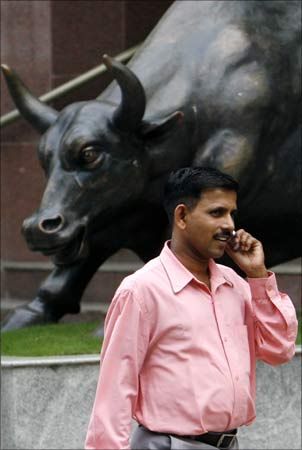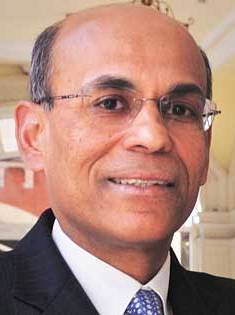 Glenwyn P Baptist, below, left, chief executive officer and chief investment officer at Pramerica International Investments, believes global markets could give modest returns in 2016.
Glenwyn P Baptist, below, left, chief executive officer and chief investment officer at Pramerica International Investments, believes global markets could give modest returns in 2016.
He is, however, more bullish on Indian equities.
Against US Fed’s interest rate forecast of 3.5-4 per cent, he expects rate hikes to be gradual and rates to end up at two per cent level in the long run.
He talks to Sheetal Agarwal about his company's India plans.
Excerpts:
What is your view on global equities for this year?
We expect most asset classes to give modest returns in 2016 and maybe even the next year with many bouts of risk-on and risk-off trades.
We saw a risk-off trade in the first couple of months of 2016, which has now reversed. I don’t think it is a start of anything long-term, but it’s simply a rebound of an oversold condition earlier this year.
We do not see huge positive catalysts for upside growth for the equities.
Markets should be driven more or less by earnings growth, which could be between three and six per cent in 2016 for most markets around the world.
Is there a probability of a fourth quantitative easing (QE4)?
There is always a probability.
In the US, the tendency of the central bank is to normalise the interest rate scenario.
So, QE4 for the US seems to be very low probability these days.
Eurozone is still relatively weak with growth expected to be one-1.5 per cent and the banking system not fully on its feet yet.
It is highly likely that the European Central Bank continues to be accommodative in terms of policy.
They have been probably the least accommodative of the three major central banks.
It is highly likely that you will see QE in some fashion, some sort of asset repurchases done by the central bank, in eurozone. Japan is committed to doing more and more QE.
They are now in the negative interest rates territory.
What is your view on the US Fed interest rate hike?
Our view is that the interest rate hike would be less than what the Federal Reserve is telegraphing today and probably will be even a bit less than what the market expects.
We don’t think there is a dramatic need for the Federal Reserve to increase interest rates sharply.
We think it makes sense for them to normalise.
The key question is what is normal.
I think the Fed’s forecast seems to be in the 3.5-four per cent range a few years from now.
Our expectation is that the longer term Fed funds rate should probably be closer to two per cent. So, we expect slower rate hikes, more gradual and probably longer before we get to normal relative to what the market is expecting.  How does India stack up vis-a-vis other emerging markets?
How does India stack up vis-a-vis other emerging markets?
India is certainly an attractive market and it warrants being overweighted in most emerging market portfolios. Growth rates as well as earnings expectations are very strong in India.
The institutions here have demonstrated that they have a commitment to stability whether it is the Reserve Bank of India or the recent Budget.
Clearly, the government and the corporate sector understand that India needs to compete in a global environment and there are things that they need to do to attract capital.
It looks like India is doing those things. Indian market returns will be in line with earnings growth.
One could easily expect to see 10 per cent-plus returns in the Indian markets in 2016.
The good news from the Budget was that it gave investors some confidence that the institutions in India are focused on the future growth and stability in the country.
It did not come up with negative surprises and the government is committed to maintaining fiscal deficit at 3.5 per cent.
There is a commitment to certain sectors of the Indian economy that need to be pushed such as infrastructure, rural economy.
China is one of the more difficult plays to make because China should not be looked at as one market, but as two.
Whether you look at the steel names or the shipping names or the banking and financials names (in China), they are all relatively low value in terms of their price to book ratios.
But, expectations for them are not that positive.
On the other hand, there is a whole lot of burgeoning sectors such as TMT (technology, media and telecommunications), biotech, healthcare consumer products, etc, where earnings expectations are substantially higher.
We need to invest in the companies that have the potential to report high growth and avoid those that are subject to over-capacity.
Commodities have seen some sort of rebound. What's driving the prices higher, and how much of the rally is sustainable?
Decline in oil price was driven mostly by excess supply primarily in the US shale market.
Until you see that excess supply begin to be taken out, its difficult for oil to find a true bottom.
In the US, as oil declined below $40 a barrel, more and more oil rigs are being taken out.
But at the same time you have Iran which will come on board with new oil supply.
So thats going to keep oil probably in relatively low range for some period of time.
Today the market may have gone a little bit ahead of itself. I do not personally think this kind of momentum is sustainable.
With China slowing down obviously base metals are in oversupply because demand has dropped.
That said I think the fears about China slowdown are overdone.
Many of the base metals prices have overshot probably to the downside.
But, I dont see a substantial new catalyst like we saw China post the global financial crisis coming to drive commodities like iron ore, copper, etc higher. Once the supply-demand balance is restored, there will be potential to see metals prices stabilise and move to higher levels.
Company's interests in India and growth strategy going forward?
We are very excited about the Indian market and have been operating in this market now for about 5-6 years.
In the last year we have made two very important moves that talk about our strategy.
First is our JV with DHFL.
Our view is that in most emerging markets you must have a local partner to be successful.
Its not enough for you to have a global asset management presence which we certainly have at Prudential.
We have over a trillion dollars in assets under management.So we have all of that expertise.
But each local market is different.
So we thought it was very important to have a local partner and in DHFL we found the right partner.
So we have a partnership with them on both the insurance and the asset management side.
The second thing that we did was the acquisition of Deustche Bank schemes.
We are very excited that we have closed the transaction and have started putting the new company together under the leadership of Suresh Soni, who was the CEO of the Deustche Bank team.
The asset management business is a business of scale.
You cannot profitably operate as a small player and we knew that at the get go.
So we have been looking for an acquisition all these years that we have been here and finally we have found the right one. Both DHFL and ourselves are committed to providing the team with resources.
Whether its on the investment side or the sales side or the client service side, these are all bigger now than they were in either company prior to the acquisition.
Our product suite has become much larger, so have the schemes post the merger.
We have a commitment to support the team and give them the tools they need to continue to grow.
And we will do all we can to bring ideas, best practices, and products from overseas markets to the local team where its needed.












 © 2025
© 2025